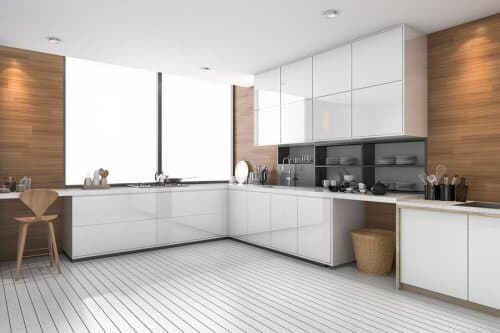
L-Shaped Kitchen Layouts – Benefits And Drawbacks
L-shaped kitchen layouts seemingly originated from the 1950s. These layouts provided a decent amount of room for large family gatherings around the dinner table. After the 1950s, gallery kitchens made their way into the scene and they had a decent run that provided a nice, spacious feeling to the room.
When the 1970s and 1980s came around, U-shaped kitchens started popping up all over the place and these layouts provided a lot of space and kitchen effectiveness for cooking.
After that, Island kitchens rolled around the corner, and they were exceedingly popular for those who enjoyed the open floor concept plans where the kitchen melds into the living room areas.
L-Shaped Kitchen Layouts
Throughout all of these years, L-shaped kitchen layouts still persisted and they are the result of years and years of research in the kitchen industry. L-shaped kitchen layouts are incredibly common because they can work into many different housing plans.
L-shaped kitchens have kitchen counter space to cook and bake on, and typically have two adjoining walls that run perpendicular to one another. This allows for a traffic-free cooking zone without any interruptions.
These designs provide lots of wall space where you can store items, or you can as well just turn it into an L-shape kitchen with an island. The kitchen will resemble an L-shape design where all of your appliances will be against each of the walls, and the other area can be used to store other essential kitchen tools.
If you’re wanting to increase the storage space in your kitchen, you can think of using stacked wall cabinets. Most of them are only around a foot in-depth and you can stack them vertically up the wall as high as you’d like. You could also get some wall cabinets right on the floor. Three feet high wall cabinets work well for this. Getting a shallow countertop installed is another option. This gives you the opportunity to place wall cabinets above it. Some people like to get a pass-through window installed to open up the room a bit.
Cabinets that are about one foot deep don’t typically hold a lot of the bigger objects like pots or pans, but they are ideal for smaller kitchen accessories. Wall cabinets also won’t dig into your wallet as much as base cabinets will.
One thing to keep in mind is if you choose to go with wall cabinets, you’ll need to get a toe kick installed. If you don’t, you run the risk of not being able to open up the cabinet doors.
Benefits Of L-Shaped Kitchens
- They make good use of corner space.
- They work well with small to medium-sized kitchens.
- You can customize their length.
- The kitchen can be divided up nicely into various cooking sites.
- There won’t be much traffic through the kitchen.
- You can add eating spaces in various areas very easily.
Disadvantages Of L-Shaped Kitchens
- They don’t work as well for larger-sized kitchens.
- They aren’t the best if there are multiple individuals cooking in the kitchen.


